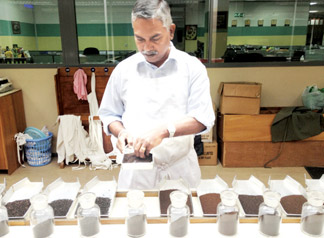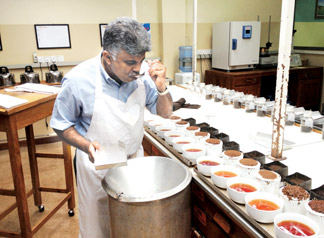|
Tea Tasting:
Sri Lanka boasts of nearly 30 grades of tea
By Kurulu Kariyakarawana
Tasting tea as a profession is an art that can be mastered only with
special training and skill. It is the process that a taster determines
the distinctive quality of Camellia Sinensis plant or popularly known as
tea that is grown in different terrains under different climatic
conditions and being manufactured according to different processes.
|

A tea taster examining tea |
|

A tea taster at a tasting session |
Having owned a global reputation for its speciality teas for over a
century and being the leading exporter for decades, Sri Lanka boasts of
nearly 30 grades of tea being processed through the cultivations in
central highlands and southern lowlands that are categorised into seven
tea growing regions.
The colour, taste, texture and aroma of a cup of tea brewed from the
produce of each of these regions holds a unique character that can be
recognised by the trained tasters as well as international and local tea
lovers.
In Sri Lanka mainly the tea plantation is categorised into three
different terrains as high grown, medium grown and low grown tea. The
mentioned regions are based on the elevation of the ground being used
for the cultivation. It also defines the climatic conditions pertaining
to each terrain or the region.
Sri Lanka Tea Board has categorised these regions as Kandy, Nuwara
Eliya, Uda Pussellawa, Uva, Dimbula, Sabaragamuwa and Ruhuna. Areas that
have an elevation over 1,200 metres of the sea level are considered to
be high grown and between 1200 metres to 600 metres are marked medium
grown tea. The terrains lower than 600 metres are considered to be low
grown. Uda Pussellawa, Haputale and Nuwara Eliya regions fall into high
grown region whereas Uva, Dimbula and Kandy belong to medium grown.
Areas like Galle, Matara, Ratnapura come under Ruhunu and Sabaragamuwa
regions of low grown.
The flavour of the tea differ from the elevation of the ground it is
cultivated. High grown tea which is relatively a smaller leaf has a
subtle and delicate flavour whilst low grown teas bear a stronger
flavour and a relatively larger leaf.
Ability to taste tea and define its characters has to come with years
and years of experience and training. Jayathilaka Vidana, a senior tea
taster in the trade with over a decade of experience said that flavours
of the tea differ due to many factors. The characters of the taste can
be differed due to the elevation of terrain, climatic condition,
regions, from estate to estate, tea harvested from one side of the hill
of an estate to the another side.
The tea produced in Sri Lanka is generally known as Orthodox Black
Tea and categorised into 28 grades depending on the region, type and
style they are processed and produced. They are also graded according to
the leaf particle size like whole leaf or semi broken leaf which chiefly
affects its flavour. Popular grades like BOP (Broken Orange Pekoes), BOP
Fanning (BOPF), Golden Tips and Silver Tips have a large demand
internationally. CTC (Crush, Tear, Curl) style teas are also produced in
the country.
Tasting is usually conducted in a spacious room where a range of
brewed cups of teas are arranged in a line on a long table. Next to each
cup a small sample of the respective tea is arranged for the tasters to
examine. The tasting is done with a tablespoon by slurping a spoonful of
tea. The slurping is done swiftly and noisily for the oxygen and the
liquid to pass through all the taste receptors on the tongue and the
palate to embrace the full flavour of the sample. The content is then
spat out into a spittoon and continues the same process with the
remaining cups.
Tea tasters have a unique language to describe the characters of the
tea they have tasted and to grade them into varieties or to approve or
reject a batch. These languages or codes are unique to every company to
evaluate the quality of tea they purchase from the auction. For example,
a taster can evaluate a cup of tea he had tasted from 1 to 10. Apart
from the good characters the faults are also recognised by the tasters.
They are able to tell whether the tea is burnt or smocked or not up to
the proper standard suitable for human consumption.
An experienced taster can simply tell the type, the region and also
the estate of the tea was plucked and produced. However there are
certain unique qualities that even a beginner can notice. Especially the
colour of the low grown and the high grown tea can be identified by its
colour. The low grown tea has a dark reddish colour whereas high grown
tea has a light yellow mix orange.
A tea plant was first brought to Sri Lanka in 1824 by the British
from China where it was planted in Royal Botanical Gardens in Peradeniya
for experimental purposes. Then several plants were imported
subsequently from India in 1839 which led to the fact that its
cultivation was far more successful than coffee. In 1839 the Ceylon
Chamber of Commerce was established. James Taylor, the Britisher
initiated commercial plantation of tea in 1867 by starting to grow a 19
acre estate in Kandy and a factory built in 1872. The first batch of
Ceylon tea was exported to England from this estate.
Since then it grew to become one of the main exports of the country
with several hundred estates within the regions and over 200 local
companies that export tea. The tea produced in the factories are being
bought over by brokering companies who would sell them in the Colombo
Tea Auction held by Ceylon Chamber of Commerce under the patronage of
Colombo Tea Traders Association.
Eight leading brokering companies namely Forbes and Walker Brokering
(Pvt) Ltd, John Keels PLC, Ceylon Tea Brokers (Pvt) Ltd, Asia Siyanka
Commodities (Pvt) Ltd, Bartleet Produce Marketing (Pvt) Ltd, Lanka
Commodity Brokers Ltd, Mercantile Brokers Ltd and Eastern Brokers Ltd
will auction the bulk of tea they purchase from the estates and
factories to exporting companies.
A number of local exporters including the leading names like Lipton
Brooke Bond, Stassen International, Akbar Brothers, Watawala
Plantations, Sunshine Tea, Mlesna Ceylon, Anverally and Sons, Imperial
Tea and many other companies take part at the auction held every Tuesday
and Wednesday.
Colombo Tea Auction is a remarkable place where time is considered as
money. Auctioning is held in three different auditoriums throughout the
day where eight categories of tea called Ex Estate, High and Medium, Low
Grown Leafy, Low Grown Small, Off Grades, BOP 1A, Dust and Supplementary
are being sold out by the brokering companies.
A single sale of tea in the auction is called a lot where the type or
grade of the tea is announced with the starting price per kilogram
placed by the respective brokering company.
Generally the auction gets about 6,000 lots to be sold within the two
days and the brokers had to announce at least three lots a minute which
has to be done by a person who is capable of ultra fast vocal abilities.
The traders will place their bids on the announced price and the best
bidder will get the stock.
Sri Lanka was the leading tea exporter in the world until the last
decade whereas now it has dropped down to the fourth position having
China, India and Kenya respectively on top.
The amount of metric tons exported since 2010 to 2012 had been
dropped with 331,427 in 2010, 328,632 in 2011 and 326,278 in 2012.
Tea Grades Nomenclature
Orthodox Black Tea Main Sale
1 BOP 2 BOPA 3 BOPF 4 OP1 5 OP 6 OPA 7 BOP1 8 FBOP1 9 FBOP 10 FBOPF
11 FBOPF1 12 FBOPF Special 13 FBOPF Extra Special 14 FBOPF Extra Special
1 15 Pekoe Pekoe 1 16 Dust 1 17 Dust 18 BP 19 BOP1A 20 BM 21 BT 22 FNGS
1 23 FNGS
CTC Tea
1 BP 1 2 BPS 3 PF1 4 OF 5 PF 6 PD 7 Dust 1 8 Dust |


